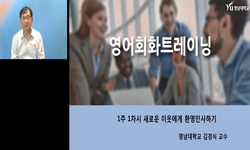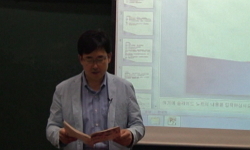朝鮮王朝 後期 英·正祖는 社會的으로나 文化的으로 安定된 時期였으며, 이러한 時代的인 토양에서 文人畵의 自主的인 發展올 보게 된다. 전반적으로 儒敎思想에 의해 人格修養이 된 선비...
http://chineseinput.net/에서 pinyin(병음)방식으로 중국어를 변환할 수 있습니다.
변환된 중국어를 복사하여 사용하시면 됩니다.
- 中文 을 입력하시려면 zhongwen을 입력하시고 space를누르시면됩니다.
- 北京 을 입력하시려면 beijing을 입력하시고 space를 누르시면 됩니다.
https://www.riss.kr/link?id=T3215249
- 저자
-
발행사항
서울 : 동덕여자대학교, 1988
-
학위논문사항
학위논문(석사) -- 동덕여자대학교 대학원 , 미술학과 회화전공 , 1988. 8
-
발행연도
1988
-
작성언어
한국어
- 주제어
-
KDC
650
-
발행국(도시)
서울
-
형태사항
iii, 54 p. : 도판 ; 26cm
- 소장기관
-
0
상세조회 -
0
다운로드
부가정보
국문 초록 (Abstract)
그러나 내용상으로 볼 때 中庸思想에 영향을 받은 韓國的인 文人畵는 後期에 오면서 中國의 소위 精神修養을 으뜸으로 여기는 禪宗思想의 유입으로 인해 점차 현실도피의 은둔사상과 結合되며, 이로써 逸品畵로서의 새로운 경지를 보이게 된다. 그러므로 韓國的인 文人畵는 결과적으로 우리의 특유한 自然觀을 바탕으로 한 순수 예술경지를 표현할 수 있게 되었으며 儒敎思想과 함께 禪宗思想이 가미됨으로써 소위 南宗 文人畵를 발전시켜 나갔다.
이 論文에서는 주로 朝鮮後期 畵家들과 그 作品들이 韓國的 美感을 形成하는데 기여하였음을 考察해 보았고, 또한 오늘의 화단에 지대한 영향을 미친 明末 淸初 時代의 遺民畵家들이 미친 영향과도 관련지어 살펴보았다.
讀書的인 人格修養에 기반을 둔 文人畵의 畵意的 特性에는 現實에 대한 초탈의 경지가 반영되며, 이는 韓國人의 전통적인 巫俗信仰에 보이는 風水地理思想과 더불어 결과적으로 獨自的인 畵風을 形成하는데 큰 영향을 미친 것으로 본다.
본 論文에서는 그 時代의 文化的, 社會的인 배경이 새로운 文人畵 形成에 있어 결정적인 영향을 미친다는 점에 力點을 두었다.
朝鮮王朝 後期 英·正祖는 社會的으로나 文化的으로 安定된 時期였으며, 이러한 時代的인 토양에서 文人畵의 自主的인 發展올 보게 된다. 전반적으로 儒敎思想에 의해 人格修養이 된 선비사회에 기본바탕을 둔 文人畵는 朝鮮朝 後期에 이르면 이러한 독서계층의 활발한 활동에 힘입어 주로 畵意的 形成에 있어서 괄목할만한 發展上을 보게 된다. 초기의 中國的인 모방에서 부터 벗어나게 될 뿐만 아니라, 한 次元 높은 韓國的 精緖와 부합된 순수畵風을 창출해 내기에 이르는 것이다.
그러나 내용상으로 볼 때 中庸思想에 영향을 받은 韓國的인 文人畵는 後期에 오면서 中國의 소위 精神修養을 으뜸으로 여기는 禪宗思想의 유입으로 인해 점차 현실도피의 은둔사상과 結合되며, 이로써 逸品畵로서의 새로운 경지를 보이게 된다. 그러므로 韓國的인 文人畵는 결과적으로 우리의 특유한 自然觀을 바탕으로 한 순수 예술경지를 표현할 수 있게 되었으며 儒敎思想과 함께 禪宗思想이 가미됨으로써 소위 南宗 文人畵를 발전시켜 나갔다.
이 論文에서는 주로 朝鮮後期 畵家들과 그 作品들이 韓國的 美感을 形成하는데 기여하였음을 考察해 보았고, 또한 오늘의 화단에 지대한 영향을 미친 明末 淸初 時代의 遺民畵家들이 미친 영향과도 관련지어 살펴보았다.
讀書的인 人格修養에 기반을 둔 文人畵의 畵意的 特性에는 現實에 대한 초탈의 경지가 반영되며, 이는 韓國人의 전통적인 巫俗信仰에 보이는 風水地理思想과 더불어 결과적으로 獨自的인 畵風을 形成하는데 큰 영향을 미친 것으로 본다.
본 論文에서는 그 時代의 文化的, 社會的인 배경이 새로운 文人畵 形成에 있어 결정적인 영향을 미친다는 점에 力點을 두었다.
다국어 초록 (Multilingual Abstract)
In general, the scholar society whose foundation of self cultivation had been Confucianism was the fundamental nature of MunInHwa and towards the latter period of Chosun Dynasty, its energetic activity gave an outstanding enhancement in artistic formation. Not only they escaped early imitation from China but also created a higher dimension of pure painting style that corresponded traditional Korean emotion.
However, towards the latter period of chosun dynasty, the Korean MunIn Hwa what had been influenced by moderation thought in content, began to show anti-actualism of seclusion because of an inflow of the zen Buddhism whose the most importance was the mental cultivation and created new horizon in IlPumHwa.
The outcome was the expression of the pure artistic style on the base of characteristic naturalism and together with Confucianism, the addition of the Zen sect of Buddhism thought gare development of NamJong MunInHwa.
In this report, the discussion is on the contribution of artists and their works on the Korean sense of beauty at the end of late Chosun Dynasty in connection with the YuMin astists of late Myeong early Chung Dynasty that still influences artists nowadays.
MunInHwa's artistic emotion reflects the transcendence from reality and together with the theory of wind, water and geology, they influenced a great deal in the formation of its independent artistic nature.
This report emphasizes specifically an the cultural and social background's decisive influence in the formation of the new MunInHwa.
The latter period of King Young-Cho and King Jung-Cho of Chosun Dynasty was socially and culturally a stable environment that resulted in autonomous development of MunInHwa. In general, the scholar society whose foundation of self cultivation had bee...
The latter period of King Young-Cho and King Jung-Cho of Chosun Dynasty was socially and culturally a stable environment that resulted in autonomous development of MunInHwa.
In general, the scholar society whose foundation of self cultivation had been Confucianism was the fundamental nature of MunInHwa and towards the latter period of Chosun Dynasty, its energetic activity gave an outstanding enhancement in artistic formation. Not only they escaped early imitation from China but also created a higher dimension of pure painting style that corresponded traditional Korean emotion.
However, towards the latter period of chosun dynasty, the Korean MunIn Hwa what had been influenced by moderation thought in content, began to show anti-actualism of seclusion because of an inflow of the zen Buddhism whose the most importance was the mental cultivation and created new horizon in IlPumHwa.
The outcome was the expression of the pure artistic style on the base of characteristic naturalism and together with Confucianism, the addition of the Zen sect of Buddhism thought gare development of NamJong MunInHwa.
In this report, the discussion is on the contribution of artists and their works on the Korean sense of beauty at the end of late Chosun Dynasty in connection with the YuMin astists of late Myeong early Chung Dynasty that still influences artists nowadays.
MunInHwa's artistic emotion reflects the transcendence from reality and together with the theory of wind, water and geology, they influenced a great deal in the formation of its independent artistic nature.
This report emphasizes specifically an the cultural and social background's decisive influence in the formation of the new MunInHwa.
목차 (Table of Contents)
- 目次
- 논문개요
- I. 序論 = 1
- II. 本論 = 3
- (1) 朝鮮朝 後期 繪畵의 文化史的 槪觀 = 3
- 目次
- 논문개요
- I. 序論 = 1
- II. 本論 = 3
- (1) 朝鮮朝 後期 繪畵의 文化史的 槪觀 = 3
- A. 時代的 背景 = 3
- B. 中國 明末淸初 繪畵思想과의 關係 = 5
- (2) 우리 나라 文人畵의 畵意的 特性 = 9
- A. 後期文人畵의 흐름 = 9
- B. 文人畵家에 의한 世俗的 관심 (眞景·風俗) = 20
- C. 우리나라의 文人畵와 中國 文人畵의 畵意的 交流 = 30
- III. 結論 = 41
- 參考文獻 = 43
- 圖版 = 45
- ABSTRACT = 53












